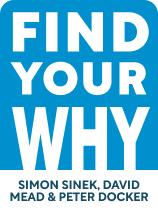

This article is an excerpt from the Shortform book guide to "Find Your Why" by Simon Sinek, David Mead, Peter Docker. Shortform has the world's best summaries and analyses of books you should be reading.
Like this article? Sign up for a free trial here .
What are the benefits of living your life with purpose? What steps can you follow to live your purpose and share it with others?
Find Your Why author Simon Sinek believes every individual and organization has a purpose. According to Sinek, “finding your Why” means finding your purpose: the single core belief that inspires you to do the work you choose to do and constantly live your life with purpose.
Read on to learn the two actionable steps for living your life with purpose, according to Simon Sinek.
How to Begin Living Your Purpose
Sinek identifies two key actions to take after you discover your purpose in life. First, identify your How: the practices and methods that characterize you and help you live your purpose. Then, share your purpose statement. We’ll discuss determining your How, or methods, and suggest ways to share these insights with others.
Step 1: Determine Your How
The first step to begin living your life with purpose is to identify your How, or what practices will help you accomplish your purpose. Sinek says your How comes from the list of themes you set aside when you drafted your purpose statement. (Themes are the ideas and actions that came up repeatedly in the stories.)
The Importance of Determining Your How
Your How is the way you operate when you’re at your best. While your Why guides you to opportunities that will bring you fulfillment, your How helps you distinguish between them to identify those that will allow you to use your best qualities and those that won’t. Although many opportunities, like potential jobs or invitations to social events, may be related to your purpose, they won’t all be right for you.
For example, your Why might be, “To help women unleash their inner power to create a life where they feel fulfilled, inspired, and empowered.” That purpose can direct you to a wide range of fulfilling opportunities, from being a life coach for women, to working at a venture capital firm that funds women-led ventures. That’s where identifying how you will live your life with purpose becomes crucial. If your practices are to “forge deep connections with individuals,” “help people find their own answers to their questions,” and “maintain a positive outlook even in challenging times,” those methods are nudging you in the direction of a life coach rather than venture capitalist.
You can also use your How to analyze your current situation. If you’re feeling discouraged by your circumstances, your How can help you identify where the discomfort is coming from. For instance, if you’re working at a company whose purpose aligns with your own but you still feel unfulfilled, it might be because the specific role you play doesn’t let you use your strengths. Perhaps one of your practices is to forge meaningful connections with people, but your job requires you to work on your own most of the time. In that case, your job is not allowing you to do your best work, even if, at the purpose level, you’re aligned.
(Shortform note: While determining your How can help you understand why some situations help you thrive while others work against you, the authors of Designing Your Life offer a way to pinpoint exactly which situations have either a positive or negative effect on you: a wayfinding journal. The journal works like a mood tracker where you list all your activities in a given period, and rate how involved, energized, and joyful you felt while doing each of them. You can then analyze the tracker to find where your involvement, energy, and joy lag or rise—and use your How to understand why.)
The Process of Determining Your How
The process of identifying your How, or methods, is the same for individuals and teams:
First, group similar themes until you have no more than five. (Remember not to use the themes you already wrote into your purpose declaration) These themes are your How, or methods. Sinek recommends stating your How in actionable language that will be easy to understand. Make the statements active, declarative, and inspiring. For example, “make room for people’s feelings” instead of “be empathetic.”
Then, elaborate on each How to make it more concrete. For instance, if a How states “we build safe communities,” you could add the following clarifying statements:
- “We look out for our community members.”
- “We create safe spaces where everyone belongs.”
- “We seek opportunities for connection.”
| Distinguish Your True Strengths From Personality Myths Besides helping you understand which situations bring out the best in you, writing down your How, or methods, is an opportunity to identify myths you might be holding about yourself. Among the themes you identified, you might have included myths about your personality—traits you believe you have and that even shape the way you tell stories about yourself, but that are inaccurate. For example, if you consider yourself organized, you might tell stories in a way that highlights that trait without considering how factually based it is. Thinking through your identified strengths and elaborating on them to make them more specific (for example, asking yourself, “How exactly am I organized?”) is an opportunity to shine a light on these myths and root them out. |
Step 2: Share Your Purpose
The final stage of Sinek’s process for living your life with purpose is to share it. Sharing your purpose helps validate your ideas with the insights of people who know you or your organization well. It also gives you the opportunity to practice using your Why to make more persuasive appeals.
Share Your Insights With Others
Sinek suggests talking with friends to check whether your purpose statement is an honest expression of your best self. Ask them what they specifically value in you as a friend. Their answer should reflect the effect you have on their life and echo your purpose statement. If it doesn’t, go back to your discussion partner, and discuss whether your friends have raised any themes worth exploring.
(Shortform note: The authors suggest a collaborative approach to validating your purpose, but this can apply to your life beyond sharing your purpose. In Designing Your Life, Bill Burnett and Dave Evans argue that since you live in collaboration with others, you should also design your life collaboratively. One way to do that is to create a team of close allies and influential people in your life who you share your life project design with and who give you feedback and support.)
Additionally, talk to the people you interact with often—both at work and in the other spheres of your life—about your Why and How. This will help them understand your motivation and strengths which, in turn, will help you collaborate more effectively with them because they’ll know where you’re coming from (your Why) and what skills you can contribute (your How).
(Shortform note: Sharing your Why, or purpose, and How, or methods, with colleagues can contribute to a culture of Radical Candor, a management style that focuses on supporting people through personal and professional problems. If you’re a leader, you can encourage your employees to share their Why and How with you. Then you can follow Kim Scott’s advice to support their ambitions and growth by analyzing their performance and growth trajectory and giving them the kind of feedback and challenges they need.)
Finally, lead with your purpose instead of your How or What when you introduce yourself to strangers. For instance, before discovering your Why, you might have introduced yourself this way, “Hi, my name is Jane. I’m a community manager, specializing in building vibrant online communities around social media influencers.”
Now, you can make a powerful pitch: “Hi, my name is Jane. My purpose is to build vibrant online communities around leaders and tastemakers so that people can find their tribes and thrive together.”
(Shortform note: Introducing yourself to strangers can be nerve-wracking, especially if you’re sharing something personal like your purpose. To overcome nerves when talking to strangers, follow the tips Keith Ferrazzi outlines in Never Eat Alone, including emulating an extroverted role model in social situations, joining clubs where you can meet people who share your interests, and setting small targets for yourself, like introducing yourself to one new person every week.)

———End of Preview———
Like what you just read? Read the rest of the world's best book summary and analysis of Simon Sinek, David Mead, Peter Docker's "Find Your Why" at Shortform .
Here's what you'll find in our full Find Your Why summary :
- Simon Sinek’s steps to understanding and living your purpose and your organization’s
- How to create and write your purpose statement
- What to do after you find your Why: Determine your How






